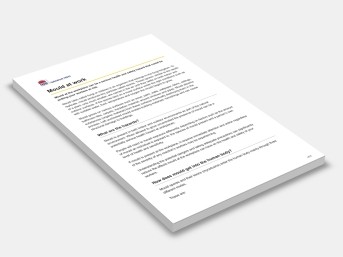Mould at work
SafeWork NSW
Mould (also called fungi or mildew) is an organism that belongs to the fungi kingdom. To replicate, mould produces tiny particles called spores. These spores, similar to the seeds of a plant, only much smaller, are carried in the air until they settle on both indoor and outdoor surfaces. If the spores land on a moist surface under the right conditions such as with suitable water, food, temperature and oxygen the mould begins to grow.
Mould grows on various surfaces such as wood, paint, walls, wallpaper, fabric, ceilings, bathroom tiles, carpets, insulation material, around windows and pipes. Mould absorbs substances (organic material) from these surfaces eventually destroying them in the process. Left unchecked mould erodes building materials, furnishings and can cause structural damage to buildings.
Contents:
What Are The Hazards?
How Does Mould Get Into The Human Body?
What Are The Harms?
Allergenic
Pathogenic
Toxigenic
Who's At Greatest Risk Of Health Problems From Contact With Mould?
Must Do's
Preventing Mould Growth
Finding Mould Growth
Cleaning Mould Contamination
Manage Dust
Completing The Mould Clean Up
Personal Hygiene Practices
Information And Training
Personal Protective Equipment (PPE)
Skin And Eye Protection
Respiratory Protection
Protective Clothing
